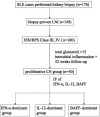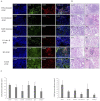Differential expression of IFN-α, IL-12 and BAFF on renal immune cells and its relevance to disease activity and treatment responsiveness in patients with proliferative lupus nephritis
- PMID: 37460249
- PMCID: PMC10357699
- DOI: 10.1136/lupus-2023-000962
Differential expression of IFN-α, IL-12 and BAFF on renal immune cells and its relevance to disease activity and treatment responsiveness in patients with proliferative lupus nephritis
Abstract
Objective: Since molecularly targeted therapies are emerging for treating lupus nephritis (LN), this study aimed to assess the immunohistochemical findings of the cytokines in renal tissue and their pathological and clinical relevance in LN.
Methods: Fifty patients with proliferative LN formed the case group; 5 with LN class II, IgA nephropathy and 10 with idiopathic haematuria were enrolled as controls. Immunohistochemical analysis for CD3, CD20, interferon (IFN)-α, interleukin (IL)-12/p40 and B-cell activating factor (BAFF) was performed by scoring the number of positive cells/area of the cortex. All immunohistochemical investigations were performed on formalin-fixed paraffin-embedded renal tissue. Proliferative LN cases were grouped by the dominant expression of IFN-α, IL-12/p40 and BAFF, and subsequently, clinicopathological features were compared.
Results: Clinical data of patients with proliferative LN included urine protein creatinine ratio, 2.2 g/gCre; anti-double-stranded DNA antibody, 200.9 IU/mL; total complement activity (CH50), 21.9 U/mL and SLE Disease Activity Index, 19.8 points. Proliferative LN cases, including class III (n=18) and IV (n=32), were classified into three subgroups according to the immunohistochemical score based on the dominancy of IFN-α (n=17), IL-12 (n=16) and BAFF group (n=17) proteins. Hypocomplementaemia and glomerular endocapillary hypercellularity were significantly increased in the IFN-α group, whereas chronic lesions were significantly higher in the IL-12 group (p<0.05). The IFN-α group had a poorer renal prognosis in treatment response after 52 weeks.
Conclusions: The immunohistochemistry (IHC) of IFN-α, IL-12 and BAFF for proliferative LN enabled grouping. Especially, the IFN-α and IL-12 groups showed different clinicopathological features and renal prognoses. The results indicated the possibility of stratifying cases according to the IHC of target molecules, which might lead to precision medicine.
Keywords: cytokines; lupus erythematosus, systemic; lupus nephritis.
© Author(s) (or their employer(s)) 2023. Re-use permitted under CC BY-NC. No commercial re-use. See rights and permissions. Published by BMJ.
Conflict of interest statement
Competing interests: SN has received consulting fees, speaking fees and/or honoraria from Bristol-Myers, AstraZeneca, Pfizer, GlaxoSmithKline, Astellas, Asahi-kasei, Sanofi, AbbVie, Eisai, Chugai, Gilead and Boehringer Ingelheim and has received research grants from Mitsubishi-Tanabe. YT has received speaking fees and/or honoraria from Behringer-Ingelheim, Eli Lilly, AbbVie, Gilead, AstraZeneca, Bristol-Myers, Chugai, Daiichi-Sankyo, Eisai, Pfizer, Mitsubishi-Tanabe and GlaxoSmithKline, and has received research grants from Asahi-Kasei, AbbVie, Chugai, Eisai, Takeda, Daiichi-Sankyo and Behringer-Ingelheim.
Figures




Similar articles
-
SLE stratification based on BAFF and IFN-I bioactivity for biologics and implications of BAFF produced by glomeruli in lupus nephritis.Rheumatology (Oxford). 2023 May 2;62(5):1988-1997. doi: 10.1093/rheumatology/keac528. Rheumatology (Oxford). 2023. PMID: 36094336 Free PMC article.
-
Interleukin (IL) 16: a candidate urinary biomarker for proliferative lupus nephritis.Lupus Sci Med. 2022 Sep;9(1):e000744. doi: 10.1136/lupus-2022-000744. Lupus Sci Med. 2022. PMID: 36104119 Free PMC article.
-
Profile of BAFF and its receptors' expression in lupus nephritis is associated with pathological classes.Lupus. 2018 Apr;27(5):708-715. doi: 10.1177/0961203317739132. Epub 2017 Oct 31. Lupus. 2018. PMID: 29087261
-
Systemic lupus erythematosus, lupus nephritis and end-stage renal disease: a pragmatic review mapping disease severity and progression.Lupus. 2020 Aug;29(9):1011-1020. doi: 10.1177/0961203320932219. Epub 2020 Jun 22. Lupus. 2020. PMID: 32571142 Free PMC article. Review.
-
Lupus nephritis and related renal disease: review from case series.Clin Exp Nephrol. 2025 May;29(5):507-520. doi: 10.1007/s10157-024-02603-6. Epub 2024 Dec 19. Clin Exp Nephrol. 2025. PMID: 39699701 Review.
Cited by
-
Machine learning identifies cytokine signatures of disease severity and autoantibody profiles in systemic lupus erythematosus - a pilot study.Sci Rep. 2024 Nov 20;14(1):28765. doi: 10.1038/s41598-024-79978-9. Sci Rep. 2024. PMID: 39567666 Free PMC article.
-
Abnormalities of IL-12 Family Cytokine Pathways in Autosomal Dominant Polycystic Kidney Disease Progression.Medicina (Kaunas). 2024 Nov 30;60(12):1971. doi: 10.3390/medicina60121971. Medicina (Kaunas). 2024. PMID: 39768851 Free PMC article.
-
Transcriptome Analysis of BAFF/BAFF-R System in Murine Nephrotoxic Serum Nephritis.Int J Mol Sci. 2024 May 16;25(10):5415. doi: 10.3390/ijms25105415. Int J Mol Sci. 2024. PMID: 38791453 Free PMC article.
-
Targeting the Type I Interferon Pathway in Glomerular Kidney Disease: Rationale and Therapeutic Opportunities.Kidney Int Rep. 2024 Oct 21;10(1):29-39. doi: 10.1016/j.ekir.2024.10.013. eCollection 2025 Jan. Kidney Int Rep. 2024. PMID: 39810777 Free PMC article. Review.
-
Circulatory microRNAs and proinflammatory cytokines as predictors of lupus nephritis.Front Immunol. 2024 Oct 11;15:1449296. doi: 10.3389/fimmu.2024.1449296. eCollection 2024. Front Immunol. 2024. PMID: 39464895 Free PMC article.
References
-
- Fanouriakis A, Kostopoulou M, Cheema K, et al. . Update of the joint European League against rheumatism and European renal Association-European dialysis and transplant Association (EULAR/ERA-EDTA) recommendations for the management of lupus nephritis. Ann Rheum Dis 2020;79(Suppl 1):1028. 10.1136/annrheumdis-2020-eular.3936 - DOI - PubMed
Publication types
MeSH terms
Substances
LinkOut - more resources
Full Text Sources
Medical
Miscellaneous
